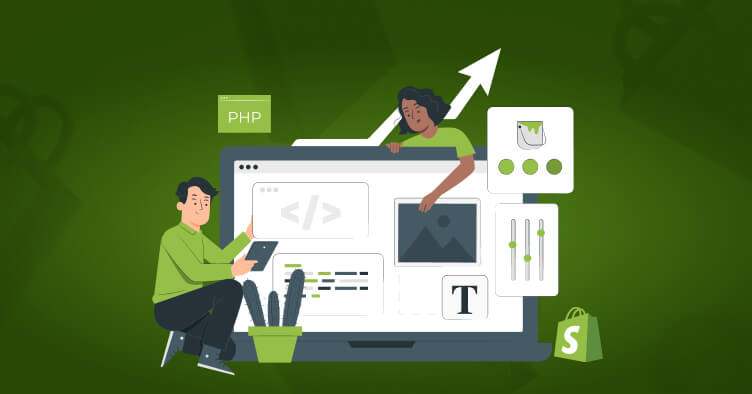Boost Business Growth with Shopify App & PHP Development
Last Updated | February 27, 2024
Table of Contents
In today’s digital era, having a strong online presence is crucial for the success of any business. Shopify, one of the leading e-commerce platforms, provides a robust and user-friendly solution to help businesses thrive online. By integrating Shopify app development and PHP, businesses can unlock a world of possibilities to enhance functionality, improve user experience, and ultimately drive sales. In this blog, we delve into how you can leverage these powerful tools to grow your business.
Understanding Shopify and PHP
Shopify: An Overview
Shopify is a popular e-commerce platform that allows businesses to set up their online store with ease. It offers a wide range of customizable templates, secure payment gateways, and a user-friendly interface, making it a go-to choice for entrepreneurs and established businesses alike.
PHP: The Server-Side Powerhouse
PHP is a server-side scripting language designed for web development. It is renowned for its simplicity, efficiency, and flexibility. When integrated with Shopify, PHP can be used to create dynamic and interactive web pages, enhancing the functionality of your Shopify store.
Leveraging Shopify App Development
Custom Apps for Unique Needs
Every business is unique, and sometimes the out-of-the-box features of Shopify may not suffice. This is where Shopify app development comes in. By developing custom apps, you can tailor the functionality of your Shopify store to meet the specific needs of your business.
Enhancing User Experience
Custom Shopify apps can significantly enhance the user experience of your store. Whether it’s a personalized recommendation engine, an advanced search filter, or a seamless checkout process, apps can play a critical role in making your store user-friendly.
Streamlining Operations
Shopify apps can also help streamline your business operations. From inventory management to order processing, custom apps can automate tedious tasks, save time, and reduce human error.
Integrating PHP with Shopify
Accessing Shopify’s API with PHP
Shopify offers a powerful API that allows developers to interact with the platform programmatically. PHP can be used to make API calls to retrieve or update data in your Shopify store, enabling seamless integration between your store and external applications.
Building Custom Solutions
By leveraging PHP, developers can build custom solutions that extend beyond the capabilities of Shopify apps. Whether it’s integrating with third-party services, processing complex data, or creating custom reports, PHP provides the flexibility and power to tailor solutions to your business needs.
Enhancing Performance
PHP’s efficiency can also contribute to the overall performance of your Shopify store. By optimizing server-side scripts, you can ensure that your store loads quickly and performs smoothly, providing a better experience for your customers.
Best Practices for Successful Integration
Ensure Security
When integrating PHP with Shopify, it is crucial to ensure that your applications are secure. Always follow best practices for security, such as sanitizing user input, using prepared statements for database queries, and keeping your PHP version up to date.
Optimize for Performance
Performance is key to providing a smooth user experience. Ensure that your PHP scripts are optimized, leverage caching where possible, and minimize the number of API calls to Shopify to avoid hitting rate limits.
Test Thoroughly
Before deploying any custom solution, ensure that it is thoroughly tested. This includes testing for functionality, performance, and security. Proper testing helps prevent issues in production and ensures a seamless experience for your users.
How do I authenticate my PHP app with Shopify?
Shopify uses OAuth for authentication. You need to implement the OAuth 2.0 protocol in your PHP app to authenticate and obtain access to a user’s Shopify store.
How can I handle webhooks in a PHP Shopify app?
You can handle webhooks by setting up a route in your PHP application to listen for webhook events from Shopify. You should also verify the webhook to ensure it’s coming from Shopify, which you can do by validating the HMAC signature.
Deployment and Maintenance:
How do I deploy my PHP Shopify app?
You can deploy your PHP Shopify app on various hosting platforms that support PHP, such as Heroku, AWS, or DigitalOcean. Ensure that you have configured your environment variables, database connections, and other necessary settings for production.
How do I update and maintain my PHP Shopify app?
Regularly check for updates in the libraries and frameworks you are using, monitor the Shopify API for any changes or deprecations, and regularly test and update your app to ensure it remains compatible and secure.
Community and Support:
Where can I find community support for Shopify App Development with PHP?
You can find community support on forums like the Shopify Community forums, Stack Overflow, and GitHub. There are also various blogs, tutorials, and documentation available online.
Are there any resources or tutorials for learning Shopify App Development with PHP?
Yes, there are numerous resources and tutorials available online. Shopify’s own documentation, as well as various blogs and tutorial websites, provide comprehensive guides on developing apps with PHP.
Troubleshooting:
How do I debug issues in my PHP Shopify app?
You can debug issues in your PHP Shopify app by checking the application’s error logs, using debugging tools like Xdebug, and ensuring that your code handles and logs errors properly.
Why is my PHP Shopify app not connecting to the Shopify API?
There could be several reasons for this, including incorrect API credentials, network issues, or misconfigurations in your code. Ensure that your OAuth authentication is set up correctly and that your API calls are correctly formatted.
Conclusion
Leveraging Shopify app development and PHP is a powerful strategy to grow your business. By creating custom solutions, enhancing user experience, and streamlining operations, you can unlock the full potential of your Shopify store. Remember to follow best practices for security, performance, and testing to ensure successful integration and a seamless user experience.
Embrace the power of Shopify and PHP, and watch your business soar to new heights!
FAQs
Why use PHP for Shopify App Development?
PHP is a server-side scripting language that is widely used for web development. Using PHP for Shopify App Development allows developers to create robust, scalable, and secure applications. It also provides a vast ecosystem of libraries and frameworks, which can simplify the development process.
How do I start developing Shopify apps with PHP?
To start developing Shopify apps with PHP, you need to set up a development environment, install the necessary tools and libraries, and create a Shopify Partner account. You can then create a new app in your Shopify Partner dashboard and start developing using PHP.
What tools and libraries are required for Shopify App Development with PHP?
You’ll need a local development environment with PHP installed, a code editor, and access to Shopify’s API. Libraries such as Guzzle for HTTP requests and a framework like Laravel can also be beneficial.









